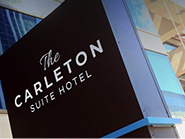An effective brand strategy helps to achieve goals.
Having an effective brand strategy in hand means much more than designing a nice logo, cobbling together a website, posting on social media and putting together a brand standards manual. In order to build a brand, you need to start with in-depth answers to key questions:
-
What are the most important objectives for your organization?
-
Who are your most valuable audiences be they customers or donors?
-
What consumer, donor or market needs are you addressing?
-
What is the competitive landscape in your industry?
Given that your brand strategy should help meet the key goals of your business or organization, it must be aligned with the multi-year strategic plan. If you don’t have a formal strategic plan, then you should at least have a well-considered plan of where you want to go and how you intend to get there.
What are the key components of a brand strategy?
Brand vision helps people understand what you stand for.
Your brand vision is an articulated description that clearly tells people what your brand aspires to be in the future. It’s what the brand ultimately stands for in the eyes of its consumers and employees. Vision adds texture and substance to a brand, allowing better judgments as to whether a program, project, person or decision is aligned with what the brand stands for.
The brand vision is seldom a one-size-fits-all undertaking and trying to shoehorn the brand into a certain number of words is usually a mistake. Fewer words are usually best but your goal should be to inspire people with your brand vision. Oxfam managed to capture its brand vision in four words - “A world without poverty.”
Brand mission statements help people understand what you do.
One of the key areas where brands struggle is being crystal clear about what they do, who they serve, what benefits they offer, how they are different and perhaps most importantly - why they do what they do. Too many mission statements are wordsmithed by committees, inwardly focused and overflowing in jargon and gobbledygook.
If your potential customers, donors, investors and so forth are struggling to understand what you do and why you do it, it’s probably because your brand mission sucks.
Whereas brand visions are meant to focused on the future and aspirational, brand mission statements should focus on the present and strive for clarity. Like, Tesla whose mission is - “to accelerate the advent of sustainable transport by bringing compelling mass-market electric cars to market as soon as possible.”
“Through comprehensive stakeholder engagement, expertise in brand strategy and the messaging skills to capture the essence of who we are, McGill Buckley has been critical in moving our brand forward. They were methodical in their approach, professional, creative and easy to work with.”
~ Danielle Côté, Director of Communications
Brand purpose is your emotional reason for being.
Ask someone in finance what a brands’ purpose is and they would likely say something like - to generate revenue and make a profit. And while that is undeniably true for survival, most consumers don’t give a rats ass about a purpose that is driven by dollar signs. What a brand purpose should aim to do is connect with customers on an emotional level - letting them know how the brand will add value to their lives and maybe even value to society as a whole.
A powerful brand purpose results when customers are put first. We use the term customer but you could just as easily replace that word with members, donors, patients, etc. A brand purpose should try to please everyone but it should aim to delight and captivate a brand’s key audiences. Dove’s brand purpose is - “Discovering the value of ‘real’ beauty and improving self-esteem worldwide.”
Like many other aspects of an overall brand strategy, the brand’s purpose must be authentic and central to the way a brand conducts itself. It is not meant to make a brand look good, it is intended to make customers feel good about being connected to the brand.
Brand promise sets expectations.
Simply put, a brand promise is a consistent experience that a company’s customers can expect to receive every single time they come in contact with that company. The more consistently a brand can deliver on its brand promise, the stronger the brand value in the mind of its internal and external audiences. In its simplest form, a brand promise comes down to - what you pinky swear to do for whom. One of the all-time great brand promises was - “When it absolutely, positively has to be there overnight.” So great was this brand promise that it became the official slogan of Federal Express and the central idea behind some classic television advertising campaigns.
Brand positioning helps separate you from the competition.
A brand with a distinct point of difference in the minds of the consumer is a must-have. Brands that fail to differentiate themselves in the market are in danger of becoming commodities, suffering chronically low awareness or being forced to compete on price.
None of those scenarios are where a brand wants to be. Positioning is where a brand strategically determines how it will stand out from the competition in the same way that Tesla stands out in the automotive industry or Four Seasons in the hotel industry.
In rare cases, a powerful positioning can also help a brand redefine or disrupt entire categories like Apple did more than once. Having a differentiated brand position helps shrink the pool of comparison brands and contributes to consumer preference and organizational performance.
Brand personality brings a human element to your brand.
Brand personality is a structure that helps an organization mould the way people feel about its products, services and mission. When used consistently and accurately, a company's brand personality evokes an emotional response and builds positive associations that help the brand connect with customers, donors and members. It’s human nature for people to connect with personalities that are similar to their own.
While some may argue with the exact number, many would agree that there are 5 dimensions of personality that brands can fall into:
-
Sincerity (down-to-earth, honest, wholesome, cheerful)
-
Excitement (daring, spirited, imaginative, up-to-date)
-
Competence (reliable, intelligent, successful)
-
Sophistication (upper class, charming)
-
Ruggedness (outdoorsy, tough)
Many brands take the development of brand personality even further by also exploring Brand Archetypes, a brand strategy concept based on the work of psychologist Carl Jung. When properly identified, brand archetypes help reflect the personality of brands and helps to align personality with buyer personas.
There are twelve brand archetypes — The Innocent, Everyman, Hero, Outlaw, Explorer, Creator, Ruler, Magician, Lover, Caregiver, Jester, and Sage. Many well-known brands can easily fall under these archetypes including Nike (hero), Harley-Davidson (rebel), Disney (magician) and Ben & Jerry’s (Jester).
Benefits of having a brand strategy.
While some skeptics may roll their eyes at terms like purpose, promise and archetypes there are three central benefits in investing in brand strategy:
- Greater differentiation and appeal — a brand that stands out and engages.
- Customer loyalty and retention — keeping customers, members and donors connected to your brand.
- Employee engagement and alignment — an energized and inspired workforce will work harder and become ambassadors for the brand.
Think that your brand could profit from a more strategic framework? Let’s explore that together.























